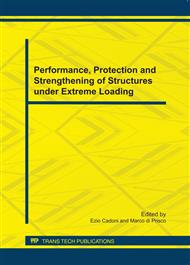p.746
p.752
p.758
p.764
p.770
p.778
p.784
p.790
p.796
Robustness Based Structural Design: An Integrated Approach for Multi-Hazard Risk Mitigation
Abstract:
Multi-story building structures can suffer local damage or even structural collapse in case of extreme natural or man-made hazards. While all buildings are at a certain risk, some attributes can reduce the risk by reducing the vulnerability. One such attribute is the use of structural systems which can ensure that, in case of abnormal loads or failure of some elements, the collapse is prevented and the risk to occupants is reduced. Mitigation of some specific hazard can also help to reduce the risk, eg. protective barriers against impact or stand-off distance against direct effects of blast. Past experience has shown that structures that are designed according to seismic design philosophy can survive to a multiplicity of hazards. The objective of the paper is the adaptation of seismic design methodology to robust design demands of multistory frame buildings prone to multi-hazard scenarios. The hazard is modeled by removal of critical members. Nonlinear dynamic analyses are carried out in order to evaluate their robustness.
Info:
Periodical:
Pages:
770-777
Citation:
Online since:
July 2011
Authors:
Keywords:
Price:
Сopyright:
© 2011 Trans Tech Publications Ltd. All Rights Reserved
Share:
Citation:


